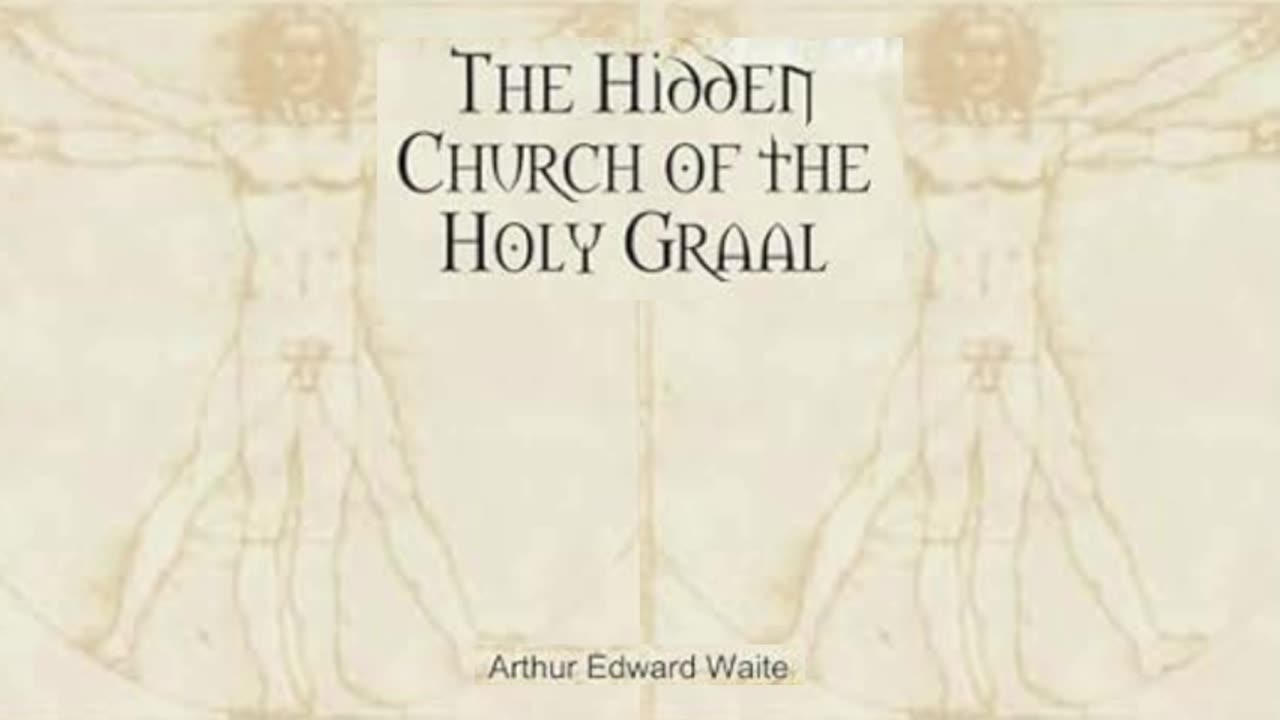Premium Only Content

The Hidden Church of the Holy Graal 2/2 by: Edward Arthur Waite
The Hidden Church of the Holy Graal (1909) is Edward Arthur Waite’s magnum opus on the mystical and esoteric dimensions of the Holy Grail legend. In this dense and richly annotated work, Waite examines the Grail as far more than a Christian relic; he presents it as a profound spiritual symbol and a veiled tradition that transcends religious orthodoxy. The book combines literary criticism, historical research, and mystical insight to uncover the Grail’s hidden meaning as a representation of humanity’s spiritual quest for divine union and enlightenment.
Key Themes and Sections:
1. The Symbolism of the Grail:
Waite interprets the Grail not as a physical object but as a symbol of divine grace, spiritual fulfillment, and the transformative journey of the soul. He examines its connections to the Eucharist, Christ’s passion, and alchemical transformation, positing that the Grail holds the keys to hidden spiritual teachings.
2. The Hidden Church:
Central to Waite’s thesis is the idea of a "Hidden Church" represented by the Grail. This esoteric spiritual tradition, existing beyond orthodox religion, unites seekers who strive for enlightenment. Waite links this invisible church to the mystical aspects of Christianity, particularly those lost or obscured by institutional dogma.
3. Arthurian Context:
The Grail legend is deeply intertwined with Arthurian myth, and Waite explores the roles of key figures like King Arthur, Sir Galahad, and Sir Percival. He interprets these characters as archetypal spiritual seekers and illuminates their quests as allegories for the soul’s journey toward divine truth.
4. Historical and Literary Examination:
Waite delves deeply into the literary origins of the Grail legend, analyzing texts like Chrétien de Troyes’ Perceval, Wolfram von Eschenbach’s Parzival, and Robert de Boron’s Grail narratives. He critiques their development and provides a comprehensive analysis of how the Grail myth evolved from its early Christian roots to its medieval romantic interpretations.
5. Mystical and Alchemical Parallels:
Waite highlights the connections between the Grail legend and alchemical traditions. The Grail becomes a metaphor for the "Philosopher’s Stone" or the ultimate spiritual attainment, reflecting the process of purification and enlightenment.
6. The Quest for the Grail:
The quest for the Grail, Waite argues, mirrors humanity’s universal longing for transcendence and divine union. He suggests that the Grail serves as a guidepost for those seeking to reconcile earthly existence with higher spiritual ideals.
Waite’s Approach:
Waite’s analysis is both scholarly and mystical. He approaches the Grail legend as a sacred allegory, rich with layers of symbolic meaning. His detailed exploration spans Christian theology, medieval literature, Rosicrucianism, alchemy, and esotericism. Throughout the book, Waite draws connections between the Grail and various mystical traditions, presenting the Grail as a universal symbol that transcends any single religion or culture.
The Book’s Structure:
Introduction: Waite outlines his purpose, explaining the Grail’s significance as a spiritual symbol and its relevance to mysticism.
Early Grail Legends: An indepth analysis of the origins and development of the Grail narratives.
The Hidden Church: Waite’s thesis on the invisible spiritual tradition symbolized by the Grail.
Arthurian Mythology: Examination of Arthurian characters and their allegorical roles in the Grail quest.
The Grail as Alchemical Symbol: Exploration of the parallels between the Grail legend and the alchemical process.
Conclusion: Waite reflects on the Grail’s enduring significance as a symbol of humanity’s spiritual journey.
Key Insights:
The Grail is not merely a Christian relic but a universal symbol of enlightenment.
The "Hidden Church" represents a mystical, esoteric tradition unbound by religious orthodoxy.
The quest for the Grail mirrors the spiritual seeker’s journey toward divine union.
Arthurian myth provides a rich allegorical framework for understanding the Grail legend.
Impact and Legacy:
Waite’s The Hidden Church of the Holy Graal is a seminal work for students of mysticism, mythology, and the occult. It offers a comprehensive exploration of the Grail legend’s symbolic depth and its connection to universal spiritual truths. While the book’s dense prose and detailed analysis may challenge casual readers, its insights remain invaluable for those seeking to understand the Grail as more than a medieval myth, but as a profound spiritual guide.
About the Author:
Arthur Edward Waite (1857–1942) was a British mystic, occultist, scholar, and prolific author known for his exhaustive studies of esoteric traditions, mysticism, and symbolism. Waite dedicated his life to uncovering hidden spiritual truths and sought to bridge the gap between mysticism and orthodox Christianity. His works remain essential reading for those interested in the deeper meanings of symbols, rituals, and mystical traditions.
Early Life and Education:
Born in Brooklyn, New York, Waite moved to England after the death of his father. Raised by his mother, Waite’s early life was marked by financial struggles, which drove him to seek deeper spiritual meaning. His interest in mysticism was sparked by the untimely death of his sister, which led him to explore spiritualism and esoteric philosophies.
Secret Societies and Fraternal Connections:
1. Hermetic Order of the Golden Dawn:
Waite joined the Hermetic Order of the Golden Dawn in 1891, a key esoteric organization devoted to ceremonial magic, alchemy, and mysticism. However, Waite’s focus on Christian mysticism and spiritual alchemy often clashed with the group’s emphasis on magical practices. In 1903, he formed his own splinter group, known as the Independent and Rectified Rite of the Golden Dawn, emphasizing mysticism and esoteric Christianity over ritual magic.
2. Freemasonry:
Waite was a dedicated Freemason, joining the fraternity in 1901. He became a member of the Societas Rosicruciana in Anglia (SRIA), a Masonic organization focused on Rosicrucian philosophy. Freemasonry deeply influenced Waite’s work, particularly his focus on symbolism, initiation, and spiritual enlightenment.
3. The Fellowship of the Rosy Cross:
In 1915, Waite founded the Fellowship of the Rosy Cross, an esoteric Christian order inspired by Rosicrucian ideals. The order emphasized spiritual regeneration, divine wisdom, and the pursuit of the mystical Christ, rejecting traditional magical practices in favor of spiritual contemplation.
4. Theosophy:
Though not formally a member of the Theosophical Society, Waite corresponded with prominent Theosophists and drew inspiration from their emphasis on spiritual unity and hidden wisdom.
Scholarly Contributions:
Waite was a prolific writer, producing works on alchemy, Rosicrucianism, Freemasonry, Christian mysticism, and the occult. His books, including The Holy Kabbalah (1929), The Book of Ceremonial Magic (1911), and The Pictorial Key to the Tarot (1910), display his breadth of knowledge and ability to synthesize complex traditions into cohesive narratives. He also cocreated the RiderWaite Tarot Deck, one of the most famous and enduring tarot decks, emphasizing its use as a tool for spiritual reflection rather than divination.
Waite’s scholarship often sought to reveal the hidden spiritual truths underlying esoteric traditions. He viewed mysticism and Christian spirituality as deeply interconnected, often referring to the "secret doctrine" that transcends orthodox dogma. His work on The Hidden Church of the Holy Graal reflects this synthesis, presenting the Grail as both a Christian relic and a universal symbol of spiritual attainment.
Legacy:
Arthur Edward Waite’s dedication to uncovering the esoteric underpinnings of mystical traditions has left a lasting impact on the study of symbolism, mysticism, and the occult. His membership in and contributions to secret societies shaped his scholarship, providing him with access to esoteric teachings that informed his writings. Though criticized by some for his dense prose and selective interpretations, Waite’s works remain foundational for students of mysticism, Freemasonry, and occult traditions. His life’s work reflects a tireless pursuit of spiritual wisdom and the unification of esoteric and Christian teachings.
-
 3:27:55
3:27:55
Deus Meum Que Jus
4 days agoJFK to 9/11: Everything Is A Rich Man’s Trick (Released November 19, 2014, in the United Kingdom)
375 -
 1:11:10
1:11:10
Steve-O's Wild Ride! Podcast
5 days ago $0.06 earnedDusty Slay Went From Selling Pesticides To Having A Netflix Special - Wild Ride #244
6.1K1 -
 1:16:02
1:16:02
CocktailsConsoles
2 hours agoBE PART OF THE GAME!!| Death Road to Canada | Cocktails & Consoles Livestream
2.45K1 -
 LIVE
LIVE
Phyxicx
4 hours agoWe're streaming again! - 11/26/2024
386 watching -
 LIVE
LIVE
GamingWithHemp
4 hours agoHanging with Hemp #103
386 watching -
 21:24
21:24
DeVory Darkins
1 day ago $3.46 earnedElon Musk and Tucker Carlson SHATTER Left Wing Media
8.75K27 -
 15:13
15:13
Stephen Gardner
1 hour ago🔥Breaking: Trump JUST DID the UNEXPECTED | Tucker Carlson WARNS America!
6.77K20 -
 1:18:01
1:18:01
Glenn Greenwald
6 hours agoWill Trump's Second Term Promote Economic Populism? Matt Stoller On Cabinet Picks To Fight Corporate Power; Should Liberals Cut Off Pro-Trump Friends & Family? | SYSTEM UPDATE #372
148K122 -
 2:26:30
2:26:30
WeAreChange
6 hours agoTrump To Subdue Deranged Opposition! ARRESTS Planned
119K31 -
 1:19:04
1:19:04
JustPearlyThings
7 hours agoWhy MODERN WOMEN Keep REJECTING The Redpill! | Pearl Daily
92.9K52